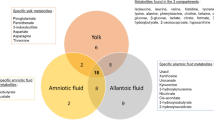Abstract
It has been proposed that variations in relative yolk weight in a population of meat-type fowl be used as a model of development of nidicolous and nidifugous birds. During development of the eggs with a high proportion of yolk, an excess of lipids is cleaved at a higher rate and oxidized until day 17 of incubation, while in the embryos developing from the eggs with a low relative yolk weight, amino acids are intensely cleaved during the period preceding the hatching. Significant differences in the body content of cystine were found in 17-day embryos and upon hatching, thus suggesting a delayed activity of the genes encoding keratins in the group corresponding to the seminidicolous type according to the egg content of lipids. These biochemical differences question the widespread concept on the occurrence of dichotomy by the end of embryogenesis and beginning of neonatal growth of nidifugous and nidicolous birds.
Similar content being viewed by others
REFERENCES
Broquist, H.P., Carnitine Biosynthesis and Function, Fed. Proc., 1982, vol. 41, pp. 2840–2842.
Carey, C., Structure and Function of Avian Eggs, Growth and Development of Birds, O’Connor, R.J., Ed., Chichester: Wiley, 1984, pp. 69–103.
Carey, C., Rahn, H., and Parisi, P., Calories, Water, Lipid and Yolk in Avian Eggs, Condor, 1980, vol. 82, pp. 335–343.
Christensen, V.L., Havenstein, G.B., and Davis, G.S., Egg Characteristics, Carbohydrate Metabolism, and Thyroid Hormones in Late Chick Embryos from Different Genetic Lines, Poult. Sci., 1995, vol. 74, pp. 551–562.
Fisinin, V.I., Zhuravlev, I.V., and Aidinyan, T.G., Embrional’noe razvitie ptitsy (Embryonic Development of Fowl), Moscow: Agropromizdat, 1990.
Freeman, B.M., The Metabolism of Hepatic Glycogen in Gallus domesticus at the End of Incubation, Comp. Biochem. Physiol., A: Comp. Physiol., 1969, vol. 28, pp. 1169–1176.
Goldberg, A.L. and Wenchang, T., Regulation and Significance of Amino Acid Metabolism in Skeletal Muscle, Fed. Proc., 1978, vol. 37, pp. 2301–2307.
Hussein, S.M., Harms, R.H., and Jancky, D.M., Research Note: Effect of Age on the Yolk to Albumen Ratio in Chicken, Poult. Sci., 1993, vol. 72, pp. 594–597.
Izkenov, N.T., Kleimenov, S. Yu., Zhuravlev, I.V., et al., Respiration and Heat Production in Chick Embryogenesis, Ontogenez (Moscow), 1985, vol. 16, pp. 518–520.
McNabb, F.M., Dunnigton, E.A., and Freeman, B.M., Thyroid Hormones and Growth Patterns of Embryonic and Post-hatch Chicken from Lines Selected for High and Low Juvenile Body Weight, Growth Devel. Aging, 1989, vol. 53, pp. 87–92.
North, M.O. and Bell, D.D., Commercial Production Manual, Amsterdam: Van Nostrand Reinholds, 1990.
Powell, B.C., Kemp, D.J., and Partington, Y.A., Control of Feather Keratin Synthesis by the Availability of Keratin mRNA, Biochem. Biophys. Res. Comm., 1976, vol. 68, pp. 1263–1271.
Raimbault, S., Dridi, S., and Denjean, F., Uncoupling Protein Homologue Putatively Involved in Facultative Muscle Thermogenesis in Birds, Biochem. J., 2001, vol. 353, pp. 441–444.
Ricklefs, R.E., Composition of Eggs in Several Birds Species, Auk, 1977, vol. 94, pp. 350–356.
Ricklefs, R.E., Avian Postnatal Development, Avian Biology, New York: Academic, 1983, vol. 7, pp. 2–72.
Salamatin, A.V., Zhuravlev, I.V., Dolgorukova, A.M., et al., Morphological Features of Eggs and Neonatal Growth of Meat-type Fowl, Vestn. RASKhN, 2003, no. 1, pp. 73–75.
Starck, J.M., Structural Variants and Invariants in Avian Embryonic and Postnatal Development, Avian Growth and Development, Starck, J.M. and Ricklefs, R., Eds., New York: Oxford Univ., 1998, pp. 59–85.
Vleck, C.M. and Vleck, D., Metabolism and Energetics of Avian Embryos, J. Exp. Zool., 1987, suppl. 1, pp. 111–125.
Young, V.R. and Munzo, H.N., NT-Methylhistidine (3-Methylhistidine) and Muscle Protein Turnover, Fed. Proc., 1978, vol. 37, pp. 2291–2300.
Author information
Authors and Affiliations
Additional information
Translated from Ontogenez, Vol. 36, No. 1, 2005, pp. 3–8.
Original Russian Text Copyright © 2005 by Zhuravlev, Dolgorukova, Salamatin, Fisinin.
Rights and permissions
About this article
Cite this article
Zhuravlev, I.V., Dolgorukova, A.M., Salamatin, A.V. et al. Some features of amino acid and lipid metabolism in embryos of meat-type fowl with different yolk weight. Russ J Dev Biol 36, 1–5 (2005). https://doi.org/10.1007/s11174-005-0001-2
Received:
Revised:
Issue Date:
DOI: https://doi.org/10.1007/s11174-005-0001-2




